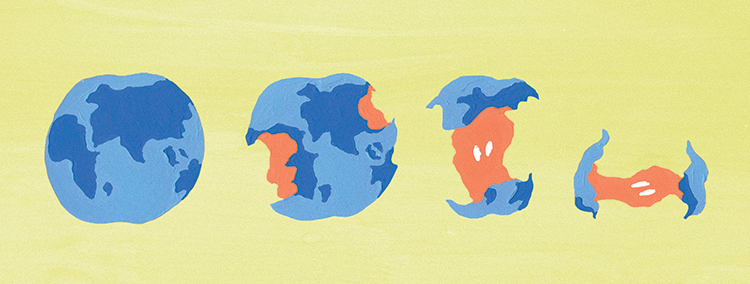Illustration by Laura Weiszer
First, Do No Harm
by Jerry Silberman
Question: How can our health care system develop the technology to cure illness?
The Right Question: How can we build a system that maintains health for people and planet?
When we think about making changes to limit the poisoning of our environment and the intensification of climate change, we usually don’t think about health care. It doesn’t make sense that protecting our health would be helping to make our planet unlivable—or does it? Let’s compare two national models of how health care is organized: the United States and Cuba.
In the United States, health care is big business, and that business is increasingly organized for profit. Individuals, even those with insurance, often bear significant—even crippling—costs for their health care. The industry accounts for 17 percent of Gross Domestic Product (GDP); $3 trillion of annual revenues ($9,500 per person annually), and employs 15.3 million people. All of these numbers are rising quickly.
Since there is a rough correlation between GDP and energy consumption, we know that health care consumes about 17 percent of all the electricity, gas, oil and coal used in our society. According to the World Health Organization, every hospital and nursing home bed in the U.S. generates about six pounds of waste daily, one pound of which is classified hazardous because it includes infectious materials, potent chemicals and drugs, or radioactive material. This understates the problem, because much of the rest of the waste is plastics, which slowly release other toxins as they decay. (Many disposables have replaced reusable tools because the subsidized cost of petroleum chemicals is cheaper than cleaning.)
Despite these massive expenditures of money and energy, America has epidemics of obesity, diabetes, cancer, autism and a host of lesser-known diseases that—like those just mentioned—were rare to unknown a century ago. Higher disease rates are partially due to better detection methods; some of it is our own doing.
Our cultural attitude toward health care reflects the dominant meme of favoring technological progress over prevention: We spend billions developing ever more expensive cures for the diseases we are creating, and we expect a techno fix for any injury we may sustain or any abuse to which we may subject our bodies. Only recently have we begun to understand that extending life at any cost and any quality is not a universal good, deserving of an unlimited investment of resources. Prevention of disease and disability is, unfortunately, a trivial part of our approach to health care.
In Cuba, by contrast, good health is considered a right; a social good that is provided at no charge to the individual. The costs, including the education and medical support to maintain the system—are borne by society as a whole. Cuba uses about 9 percent of its GDP for health care, which amounts to a per capita rate of about $605 per person per year. With such minuscule health care spending, Cubans must be a lot sicker and die younger than Americans, right?
Wrong. According to Cuban public health statistics, life expectancy and infant mortality rates are as good or better than in the United States, and, unlike in the U.S., there are no differences based on income or race. At the heart of their system is something called the polyclinic, which the World Health Organization describes as “the organizational hub for 20 to 40 neighborhood-based family doctor-and-nurse offices, and… accredited research and teaching centers for medical, nursing and allied health sciences students.” These doctor/nurse teams are members of the communities they serve, and each hub pays close attention to prevention of disease and to treating ailments by the simplest and most effective means, drawn from many traditions and technologies. All Cubans have a head start on good health, because guarantees of prenatal care, maternal education and healthy food for infants are universal. The Cuban diet generally also lacks the chemicalized junk food so dominant in the U.S., where rates of cancer and obesity are 50 percent greater.
While it is difficult to get more detailed comparisons of the health and incidence of disease between the U.S. and Cuba due to their antagonistic history, there is certainly enough to make the point: High-quality, universally accessible primary and preventive care, health and nutrition education—as well as public health measures that include eliminating poverty—are an efficient and effective use of time, money and energy, both for individuals and for our planet. Not so for the billions of dollars Americans spend on drugs and medical technology.
As our ability to exploit cheap energy resources continues to diminish over the next several decades, the resources available to invest in health care will diminish. As in every other sector of life, we will face hard choices, which will be made easier if we make the choice now to eat well and avoid environmental risks; we must also critically explore the effectiveness of relatively inexpensive, low-tech medical interventions compared with expensive, high-tech ones. In much of the world, for example, rather than surgery, non-invasive external cardiac pulsation is the treatment of choice for clogged arteries. For pain relief and musculoskeletal problems, the low-tech, low-energy therapy of acupuncture can be as—or more—effective than many expensive drug treatments or surgical interventions.
We must move our society as a whole toward prevention and low-cost, effective treatments rather than the most profitable interventions, and toward health care for all. It may be time to demand an end to for-profit health care altogether.
Jerry Silberman is a cranky environmentalist and union negotiator who likes to ask the right question and is no stranger to compromise.












